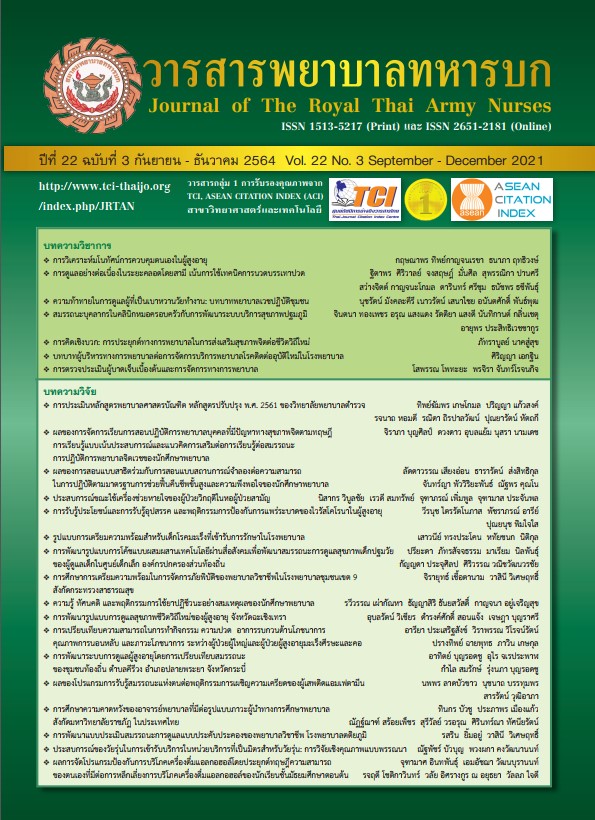The Caring for Bedbound Old Adult: A Systematic Review
Keywords:
bed bound elderly, elderly caring, quality of lifeAbstract
The aim of this systematic review of bedbound elderly caring research articles was to improve the quality of life among bed-bound elderly issues, including physically, mentally, social relationships and environment. This systematic review was conducted limited to original research articles that were published between 2011 and 2020. The articles focused on bedbound elderly caring. There were seven research articles met the inclusion both criterias with the PICos framework for qualitative research and the PICO framework for quantitative research. The data from each study were extracted by two independent reviewers.
Data Synthesis showed the caring on improve the quality of life among bed-bound elderly separate in to five parts. These were integrated together. 1) bed bound elderly self-care as self-care activity and cooperate activity for self-care, 2) by their family care, the someone was accepted as main caregiver and everyone in the family was developed to be caregivers. 3) by health volunteers, 4) by the health service system by monitoring, suggesting, screening and referring to the level of care needs, and 5) community generosity such as neighbors, community leaders, Elderly club and local government organizations they supported for bedbound elderly caring for quality of care including quality of life Literature review reveals that some health care activity of organizations in health service system and the local government organizations was complicated. That was advising, teaching, and enhancing the competence of caregivers. They should have cooperated to only one which improves the quality of life of bedridden older adult.
Downloads
References
Miljkovic N, Lim JY, Miljkovic I & Frontera WR. Aging of skeletal muscle fibers. Annalsof rehabilitation medicine. 2015; 39(2): 155-162.
Suwannarat P, Thaweewannakij T, Kaewsanmung S, Srisim K, Phonthee S, Mato L and Amatachaya S. Walking device used in community-dwelling Elderly. Journal of Nursing and Health Care. 2014; 32(3): 86-92. (in Thai)
Siripanich B. Situation of the Thai elderly. Bangkok: Amarin Printing & Publishing Public Company Limited; 2018. (in Thai)
National Health Security Office. (2016). Long-term care public health for depressed elderly people (long term care) on national health security system. Bangkok: National Health Security Office.
Kylie, P.,Judith, D.& Craig, L. JBI’s Systematic Reviews, AJN, American Journal of Nursing. 2014; 114(6): 47-52.
Jadad A, Moore RA, Carrol lD, Jenkinson CM, Reynolds JJ, Gavaghan D, et al. Assessing the quality of reports of randomized clinical trials: is blinding necessary? Controlled Clinal Trials. 1996; 17(1): 1-12.
Vudhironarit S, Pommala W and Satthathummarak A. Self-care experience of bed-bound elderly. Journal of The Royal Thai Army Nurses. 2020; 21(3): 252-261. (in Thai)
Butimal P, Isaramalai S and Thaniwattananon P. Development of nursing practice guideline for preventing complications in bed-bound elders at home. Songklanagarind Journal of Nursing. 2018; 38(3): 79-91. (in Thai)
Thamma-Aphiphol K, Srivanichakorn S, Suthisukon P and Viripiromgoo S. The model of long term care management of the bed bound elder by community. Journal of Ratchasuda College for Research and Development of Persons with Disabilities. 2012; 8(11): 20-42. (in Thai)
Jumpapong P. Development of bed bound elder care process by family nurses, and participation of family and community party network at Bangpakong districts, Bangpakong, Chachoengsao. Mahasarakham Hospital Journal. 2018; 15(3): 85-92. (in Thai)
Wlongtairuak P. Family caregivers model for bed bound elders at home. (Doctoral of Education and Social Development dissertation) Burapha University, Faculty of Education, 2018. (in Thai)
Wicha S, Manop N, Srirungrueang S, Saovapha B, Sripattarangkul S, Thabutwong N, And Maneewan T. The study of the health care service networking for the home-bound elders and bed-bound elders: Hong Ha health promotion hospital, Maetha district, Lampang province. :Health Systems Research Institute (HSRI) 2018-01
Mahamad P. Health Care Service Model for the Bed Bound Elder by Community Participation, Sungaikolok Subdistrict, Narathiwat Princess of Naradhiwas University Journal, 2018; 10(2): 51-63. (in Thai)
Sawatphol C, Pengpinit T, Senanikorn A and Srisuraphol W. Care for elderly dependents in the Northeast of Thailand. Journal of MCU Peace Studies. 2017; 5: 387-385. (in Thai)
Department of health service support. The manual of long term care for the dependent elderly by Family caregiver volunteers. Bangkok: The Agricultural Cooperative Federation of Thailand. Limited; 2016. (in Thai)
Maslow AH, Frager RD, & Fadiman F. Motivation and personality. 3rded. New York: Harper & Row Publishers; 1997.
Sunonthanam, N. The self-esteem of the elderly through line application. Journal of The Royal Thai Army Nurses. 2020; 21(2): 84 - 92. (in Thai)
Pattariga, W. and Saranunt, A. Information technology for aging society. Journal of the Royal Thai Army Nurse. 2018; 27 – 32. (in Thai)
Downloads
Published
How to Cite
Issue
Section
License
บทความหรือข้อคิดเห็นใดใดที่ปรากฏในวารสารพยาบาลทหารบกเป็นวรรณกรรมของผู้เขียน ซึ่งบรรณาธิการหรือสมาคมพยาบาลทหารบก ไม่จำเป็นต้องเห็นด้วย
บทความที่ได้รับการตีพิมพ์เป็นลิขสิทธิ์ของวารสารพยาบาลทหารบก
The ideas and opinions expressed in the Journal of The Royal Thai Army Nurses are those of the authors and not necessarily those
of the editor or Royal Thai Army Nurses Association.






